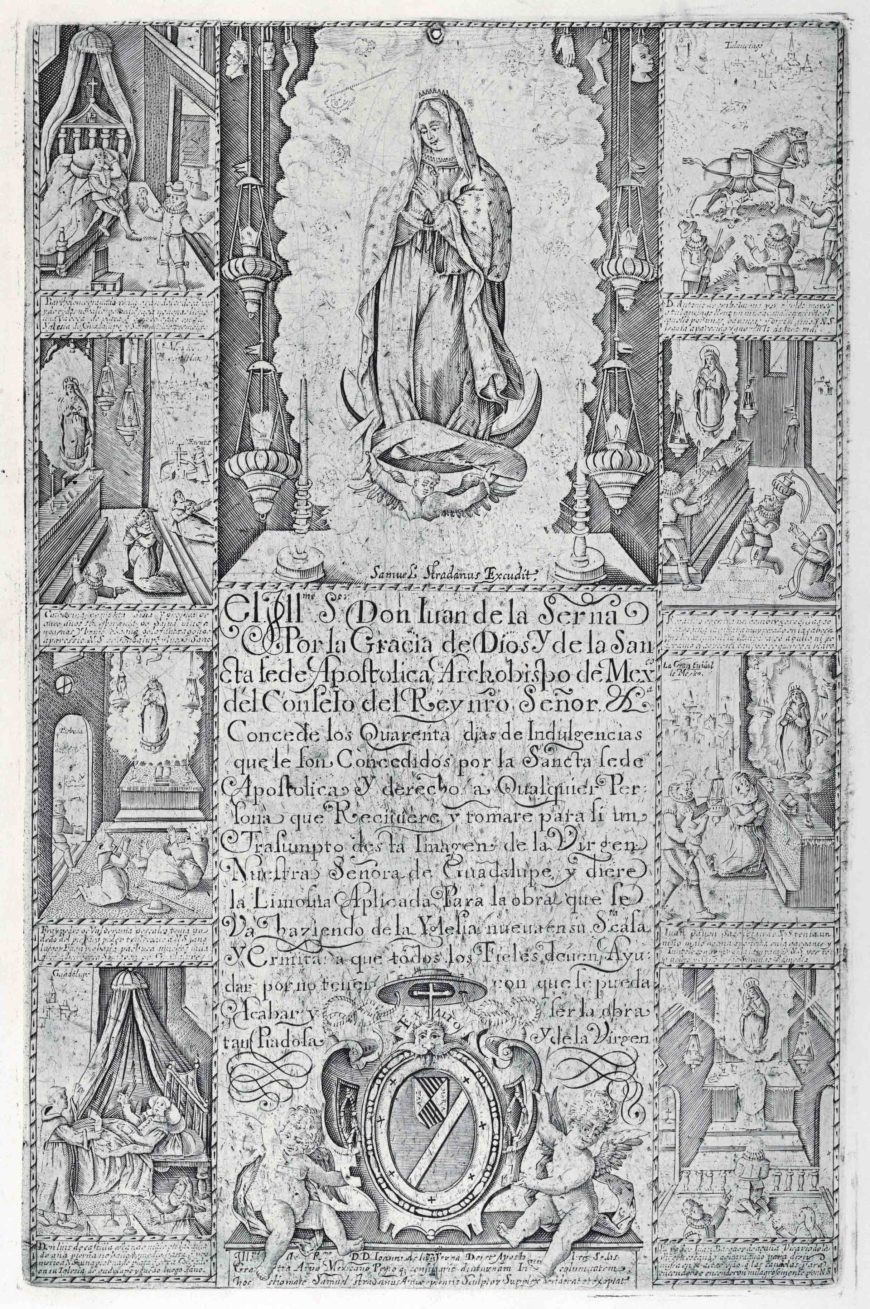
Samuel Stradanus, Indulgence for donation of alms towards the building of a Church to the Virgin of Guadalupe (modern facsimile impression), 1608 (facsimile 1930–40), engraving, 43 x 28 cm (The Metropolitan Museum of Art)
One of the earliest representations of the Mexican Virgin of Guadalupe, today patroness of the Americas and an important symbol of Mexican national and religious identity, is an engraving printed in 1608. The engraving depicts the Virgin of Guadalupe at the top of the page, seemingly hovering above an altar. Candles and hanging lamps illuminate her while ex-votos shaped like body parts testify to her powers of intercession.
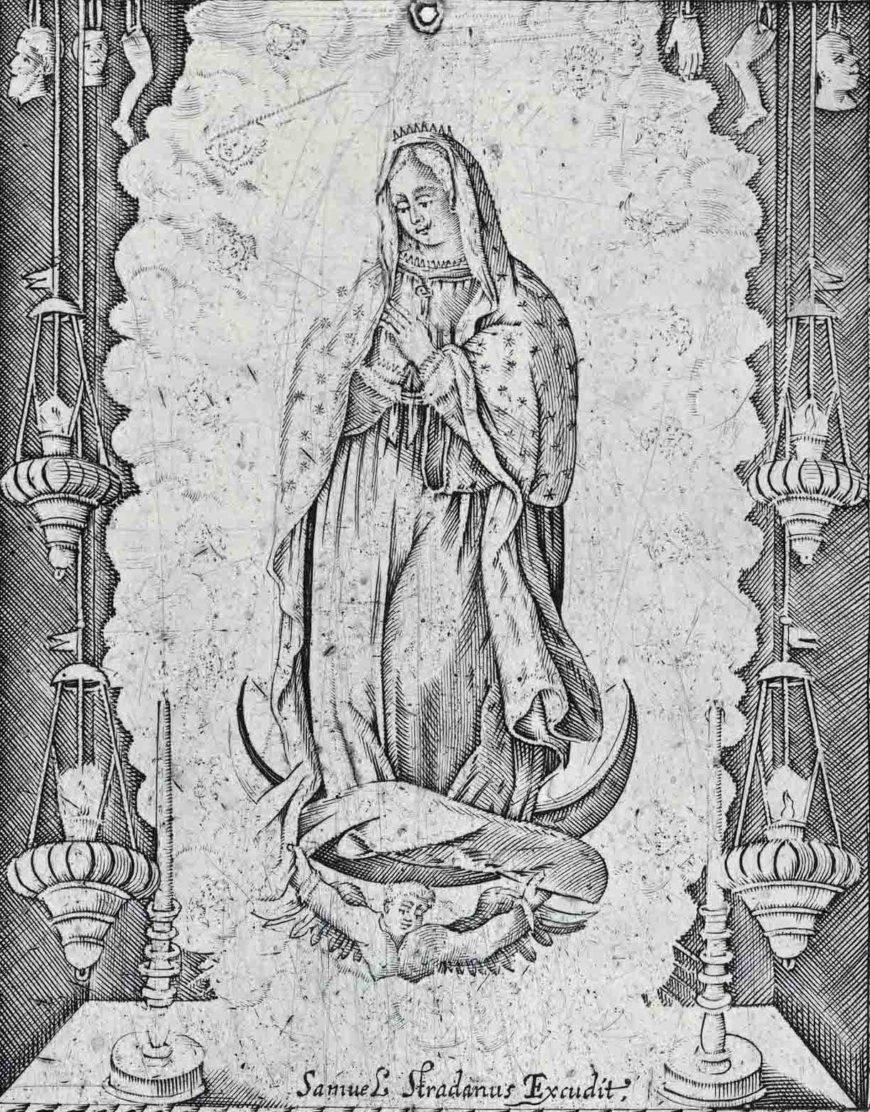
Samuel Stradanus, The Virgin of Guadalupe, detail of the Indulgence for donation of alms towards the building of a Church to the Virgin of Guadalupe (modern facsimile impression), 1608 (facsimile 1930–40), engraving, 43 x 28 cm (The Metropolitan Museum of Art)

Samuel Stradanus, border scenes of miracles associated with the Virgin of Guadalupe, detail of the Indulgence for donation of alms towards the building of a Church to the Virgin of Guadalupe (modern facsimile impression), 1608 (facsimile 1930–40), engraving, 43 x 28 cm (The Metropolitan Museum of Art)
The borders of the print incorporate small scenes narrating miracles of the Virgin, each with its own minuscule descriptive text. Prints like this one, produced in multiples by inking an engraved copperplate and then running it through a roller press so that the ink transferred from its surface onto the paper sheet, allowed for wide diffusion of an image. They became important vehicles for the promotion of religious devotions, but also for the propagation of political propaganda and for the transmission of news and scientific knowledge.
A printed indulgence
The 1608 engraving of the Virgin of Guadalupe was cut by Samuel Stradanus, one of the most important early Mexican engravers who was originally from northern Europe. He even signed it “Samuel Stradanus Excudit” (published by Samuel Stradanus). The print served as an indulgence certificate issued by Mexican Archbishop Juan Pérez de la Serna. The money raised from the sale of the indulgences was used to finance the construction of the new sanctuary of Tepeyac (where the Virgin of Guadalupe first miraculously appeared, just north of Mexico City), which was consecrated in 1622.
The printed indulgence provides testimony to the early material culture surrounding devotion to the Marian advocation. Purchasers of the indulgences received a printed image that they could keep for their own use, perhaps displaying it in their homes or place of work. Prints like this one might then become objects of prayer themselves, or even used to enact miraculous cures. The faithful lit candles before devotional prints like this one, pressed them to injured body parts, and carried them on their persons for protection.
Mexico City was the first and most important center for printing in Spanish colonial Latin America, publishing far more books and printed images than any other city in Spain’s American dominions. The first typographic press was established in Mexico City in 1539, and 73 engravers are known to have worked in Mexico City over the course of the colonial period in New Spain. During this period, prints served the needs of both the church and laity in the region, promoting state and Church orthodoxy but were also manipulated by printers to meet a devout market that did not always adhere to official conventions.
The Inquisition and Mexican prints
Religious orthodoxy was critical during this period of the Counter Reformation, and was enforced by the Holy Office of the Inquisition in Mexico City. Some Mexican Inquisition cases reveal the varied and complex ways in which inhabitants of the city engaged with these prints [1]. Many of the Inquisition cases involving prints centered on faulty inscriptions associated with those printed images. These cases reveal the complex ways in which religious prints in particular might be produced, circulated, and engaged with by viewers. For example, in 1572, Juan Ortiz, a blockcutter who produced carved woodblocks for impression, appeared before the Inquisition under suspicion of Lutheranism. He had cut a block of the Virgin of Rosary that then appeared printed alongside an inscription promising “perpetual grace” to its purchasers. The Inquisitors condemned the inscription and expelled Ortiz from the Americas, arguing he had added the text for financial rather than devotional reasons. Printed images that promised spiritual benefits to their owners demonstrate the intertwined nature of devotional and financial motives: prints claiming to have greater spiritual power might sell better on the market.
In another instance, in 1690, the Inquisition investigated prints available for sale in the town of Puebla depicting Bishop Juan de Palafox y Mendoza and the nun Catalina de San Juan (known as the “china poblana”), both popular holy figures. Both Catalina de San Juan and Bishop Palafox were uncanonized and thus not officially recognized by the Catholic Church as sanctioned subjects of devotion. The prints violated the Church’s prohibitions against devotion to unapproved figures. They also demonstrate the power of popular piety and the ability of prints to promote this kind of devotion. In response to these prints, the inquisition released an edict reiterating the prior prohibitions on images of the two figures.

Rafael Ximeno y Planes, Portrait of Jerónimo Antonio Gil, late 18th or early 19th century, oil on canvas, 81 x 116 cm (MUNAL, Mexico City)
Mexican printmaking and the Academy of San Carlos
One of the key factors that distinguishes New Spanish printmaking from printmaking in other parts of the Spanish Americas is the 1783 foundation of the Royal Academy of the Three Noble Arts of San Carlos, the first art academy in the Americas. The Spanish engraver Jerónimo Antonio Gil came to New Spain in 1778 to serve as the chief engraver to the Royal Mint. He initially established an engraving school at the mint before eventually founding the Royal Academy of San Carlos, where he also taught engraving and trained students in the Neoclassical style, popular at the time in Europe. He would serve as the Academy’s director general until his death.
Gil and his academy introduced a new kind of artistic training and production to New Spain—one grounded in Enlightenment ideas of good taste and careful study of prototypes from Greco-Roman antiquity as well as of the life model. Engravings produced by academy artists employed a precise linear syntax to reproduce works of art made in other media, such as painting. Their works used linear perspective to convey buildings and illusionistic spaces, and demonstrate a strong knowledge of human anatomy and the use of light and dark to model forms. They also exhibit a new aesthetic of clean lines, reduction of Baroque ornament, and influence of Greco-Roman architecture and idealized representations of the human body. Gil’s influence can be seen in the engravings produced by his disciples as well as in the work of artists who emerged from the Academy [2].
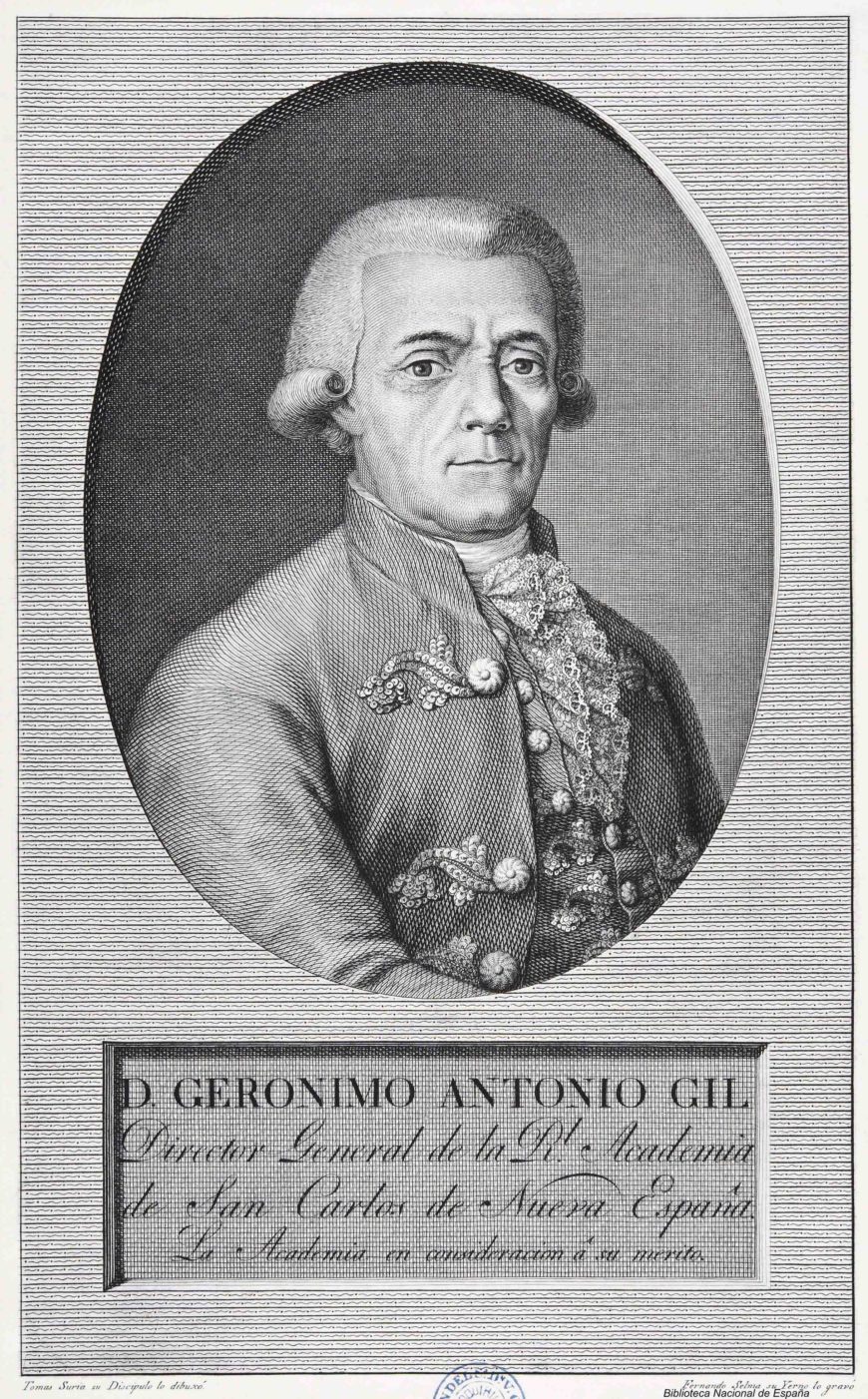
Fernando Selma, Portrait of Jerónimo Antonio Gil, c. 1783–98, engraving, 30.3 x 21.2 cm (Biblioteca Nacional de Madrid)
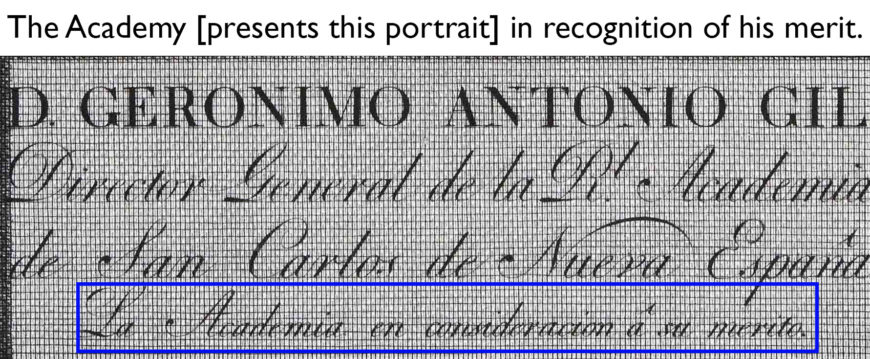
Fernando Selma, inscription, detail of Portrait of Jerónimo Antonio Gil, engraving, 30.3 x 21.2 cm (Biblioteca Nacional de Madrid)
We have two portraits of Gil, a 1796 painting by Mexican artist Rafael Ximeno y Planes and a 1793 engraving by Fernando Selma (Gil’s son-in-law) after Tomás Suria. In both, Gil is recognized for his central role in founding the Academy and portrayed as a gentleman of the Enlightenment. Selma’s engraving shows Gil gazing forthrightly out at the viewer, and he wears a fashionable wig and coat.
The text below his portrait declares Gil the Director General of the Academy and gives the reason for the production of the portrait as “The Academy [presents this portrait] in recognition of his merit” (La Academia en consideracion â su merito). Prints of important personages were frequently produced to adorn texts in their honor or for distribution to the public. Gil himself engraved numerous portraits of Mexican luminaries.
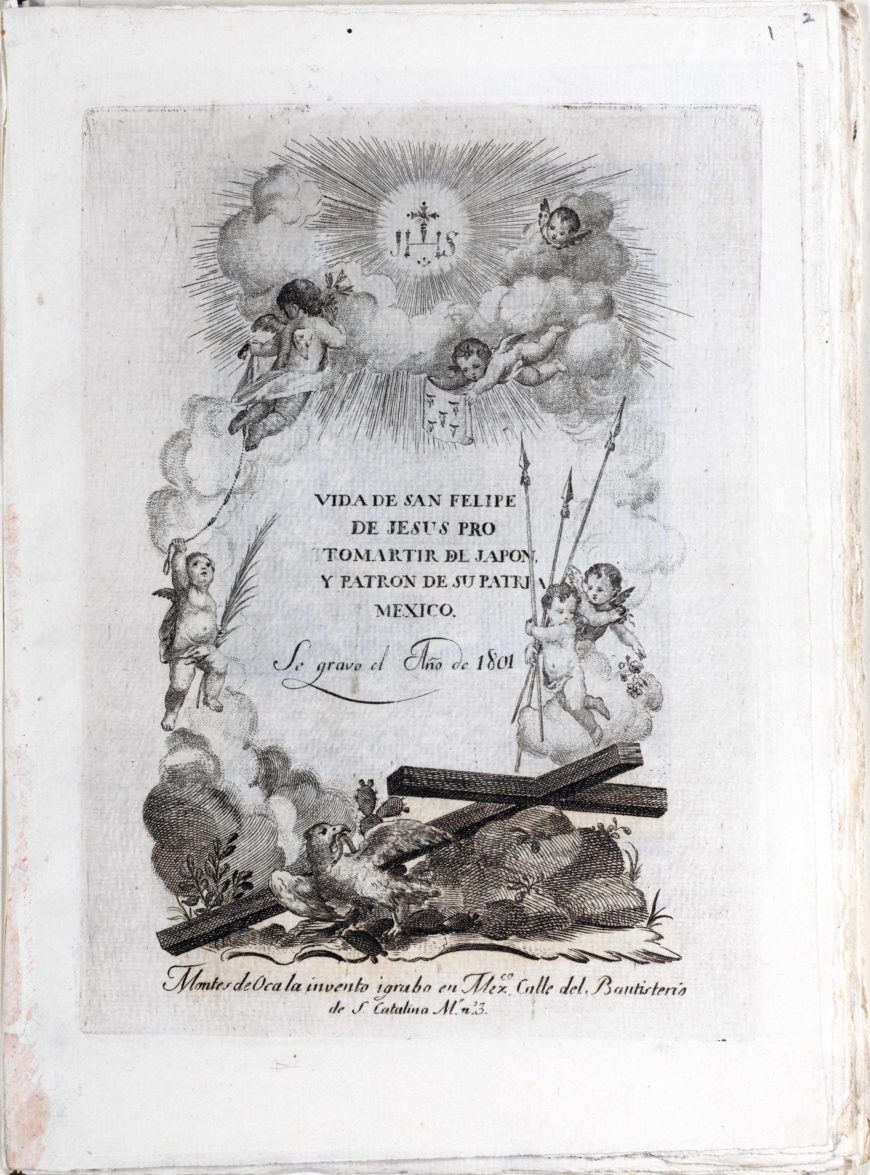
José María Montes de Oca, title page for Vida de Felipe de Jesus protomartir de Japón y patrón de su patria México, 1801, engraving, 22.5 x 16 cm (The Metropolitan Museum of Art)
One of Gil’s students, José María Montes de Oca, merits special mention for a book he self-published in 1801 immediately after leaving the Academy. The book, Life of Saint Philip of Jesus, protomartyr of Japan and Patron of His Home Nation of Mexico (Vida de San Felipe de Jesus Protomartir del Japon y Patron de su Patria Mexico), is exceptional in the whole of colonial printmaking in that it consists entirely of full-page etched illustrations without typeset text. Furthermore, all thirty etchings were designed and executed by Montes de Oca himself.

José María Montes de Oca, inscription with Montes de Oca’s signature, detail on the title page for Vida de Felipe de Jesus protomartir de Japón y patrón de su patria México, 1801, engraving, 22.5 x 16 cm (The Metropolitan Museum of Art)
Montes de Oca names himself as not only the artist but the “inventor” of the images, which narrate the life of Felipe de Jesús, a sixteenth-century martyr who had been born in Mexico but died in Japan. In naming himself “inventor,” Montes de Oca defined himself as the creator of the iconography and compositions, not simply the producer of the plates.
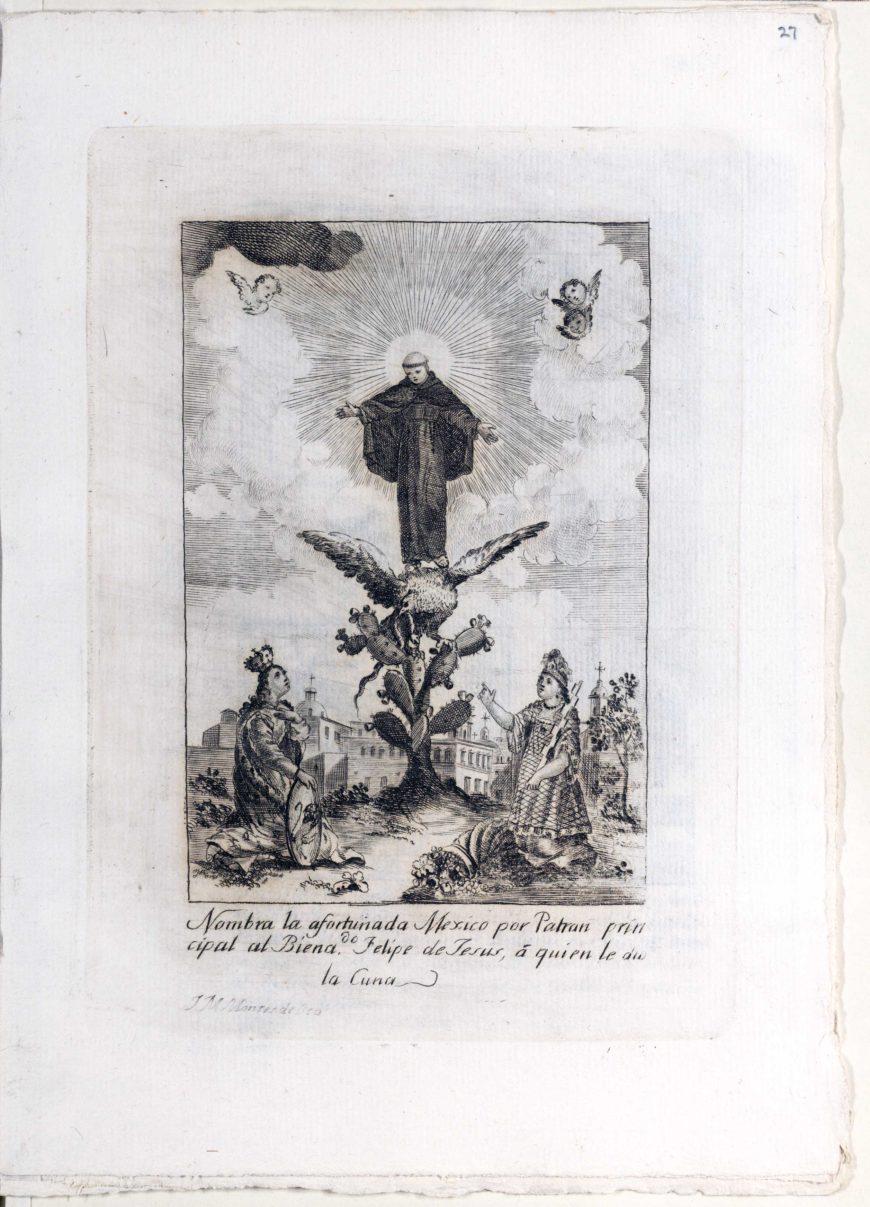
José María Montes de Oca, Felipe de Jesus with an eagle on a cactus, in Vida de Felipe de Jesus protomartir de Japón y patrón de su patria México, 1801, engraving, 22.5 x 16 cm (The Metropolitan Museum of Art)
In the best-known image from Montes de Oca’s text, Felipe de Jesus stands in glory on the back of an eagle that has perched, a snake in its beak and wings spread, on a nopal cactus, while allegorical representations of Mexico and Spain kneel before him. Felipe de Jesús opens his arms as if to embrace these allegorical figures from afar. Prints like Montes de Oca’s Felipe de Jesús series allowed for the repetition and broad circulation of images of potential saints, promoting familiarity with their remarkable deeds and admirable virtues and thus encouraging the development of devotion to them.
Why prints mattered
Printed images produced in colonial New Spain allowed for the circulation of local religious imagery and promotion of such diverse figures as the Virgin of Guadalupe and Felipe de Jesús, and the controversial Bishop Palafox and Catalina de San Juan. In the eighteenth century, with the arrival of Jéronimo Antonio Gil and the establishment of the Royal Academy of San Carlos, engraving became an important medium for promotion of new styles and modes of taste. Throughout the colonial period, this ephemeral, multiple, and reproductive medium allowed for the wide circulation of images and their corresponding ideas to a broad public, creating a shared religious and political culture.
Notes:
[1] Kelly Donahue-Wallace, “Prints and Printmakers in Viceregal Mexico City, 1600-1800” (Dissertation, University of New Mexico, 2000), chapter 6.
[2] Kelly Donahue-Wallace, Jerónimo Antonio Gil and the Idea of the Spanish Enlightenment (Albuquerque: University of New Mexico Press, 2017), chapters 4–6.




